Statement of Steve Sherrod, Acting Director of Surveillance
Division of Market Oversight, Commodity Futures Trading Commission
January 14, 2010
PROPOSED ENERGY POSITION LIMITS AND EXEMPTIONS
Good afternoon Mr. Chairman, Commissioners. Today staff is recommending the Commission approve a notice of proposed rulemaking to set Federal speculative position limits for futures and option contracts in certain referenced energy commodities. In addition, the notice of proposed rulemaking would establish a uniform process for the Commission to grant swap dealers limited risk management exemptions for certain swap transactions, in lieu of a bona fide hedging transaction exemption.
Commission regulation 150.2 currently sets Federal position limits in certain agricultural commodity markets. These limits apply to all-months-combined, single-months, and spot months. Commission regulations also authorize exemptions for bona fide hedging transactions involving commodity inventory hedges, anticipatory purchases or sales of the commodity, and non-enumerated cases. The Commission has granted exemptions to swap dealers under the non-enumerated cases provision.
In the New York Mercantile Exchange (“NYMEX”) energy markets until 2001, NYMEX set all-months-combined and single-month position limits. In 2001, NYMEX substituted position accountability requirements for the all-months-combined and single-month position limits in their energy markets.
The proposed rulemaking would leverage the Commission’s experience in setting position limits in certain agricultural markets to re-establish all-months-combined and single-month position limits in the energy markets. The proposed energy position limits build upon the agricultural limits in several ways. The proposed limits would use the same open interest formula as the one used in Commission guidance to exchanges. The limits would be responsive to the size of the market and administratively reset on an annual basis, rather than change only by rulemaking.
The proposal would impact the reporting markets of NYMEX and the Intercontinental Exchange (“ICE”). The proposed limits would apply to referenced energy futures and option contracts based on Henry Hub natural gas, light sweet crude oil (often called West Texas Intermediate or WTI), New York harbor No. 2 heating oil, and New York Harbor gasoline blendstock.
The majority of futures and options trading on energy commodities in the United States occurs on NYMEX, a designated contract market (“DCM”) that operates as part of the CME Group.1 Energy commodity trading also takes place on ICE, an Atlanta-based exchange that operates as an exempt commercial market (“ECM”) and is, as of July 2009, a registered entity with respect to its Henry Financial LD1 Fixed Price natural gas contract.2 NYMEX currently lists physically-delivered and cash-settled futures contracts (and options on such futures contracts) in crude oil, natural gas, gasoline and heating oil. ICE lists a cash-settled look-alike contract on natural gas (and options thereon) that settles directly to the settlement price of NYMEX’s physically-delivered natural gas futures contract.3
ICE’s natural gas contract and virtually all NYMEX energy contracts are currently subject to exchange-set spot-month speculative position limits that are in effect for the last three days of trading of the physically-delivered contracts. Under an exchange’s speculative position limit rules, no trader, whether commercial or noncommercial, may exceed a specified limit unless the trader has requested and received an exemption from the exchange. Outside of a contract’s spot month, these energy contracts are subject to exchange all-months-combined and single-month position accountability rules.
In re-establishing all-months-combined and single-month limits to these energy markets, staff recommends further extending the aggregation concept in the Commission’s Federal agricultural position limits. The proposed energy limits would establish a two-tiered system of limits in all-months-combined and in single-months. These limits would apply across economically similar contracts.
The first tier is an aggregate limit that would apply to positions across physically-delivered and cash-settled contracts and across reporting markets in a referenced energy commodity.
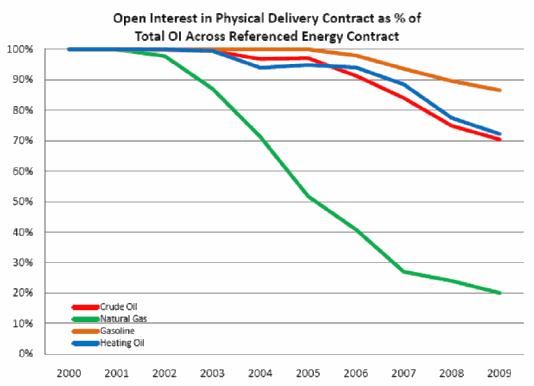
The chart above illustrates the general increase in the percent of the referenced energy market comprised of cash settled contracts. A historical approach to establishing position limits would be to set separate limits by individual contract, that is, set separately for each physically-delivered contract and each cash-settled contract. However, since the cash settled contracts are economically similar to the physically-delivered contracts, staff recommends limits be applied to a trader’s aggregate position. The aggregate limit would restrict a trader from establishing extraordinarily large positions on the same side of the market across all contracts in a referenced energy commodity. So, this means all positions of a trader in related contracts would be aggregated, regardless of reporting market or individual contract.
The second tier is a class limit that would apply to positions in economically highly similar contracts, that is, to contracts in a particular referenced energy commodity on a single reporting market that are settled in the same way, either cash settled or physically delivered. The class limits would restrict a trader from establishing extraordinarily large positions on opposite sides of the market in physically delivered and cash settled contracts in the same referenced energy commodity.
In each of the tiers, there would be limits on all-months-combined and single months.
The aggregate all-months combined limit would be set by a formula based on open interest in referenced energy contracts. The formula sets the level of the limit at 10 percent of the first 25,000 contracts of open interest and 2.5 percent of the open interest beyond 25,000 contracts. The single-month limit is set at two thirds of the all-months-combined limit.
Each class limit for positions in all months combined would be set at 30 percent of a contract’s total open interest on that reporting market, but limited to a level no greater than the aggregate limit. The single-month limit in a class is set at two thirds of that class’s all-months-combined limit.
The table below illustrates what the position limits would have been, if they had been in effect over the last ten years, and what limits would be in effect for the current year, if the Commission adopts a final regulation.
All Months Combined Referenced Energy Commodity Speculative Positions Under the Proposal (Historical)
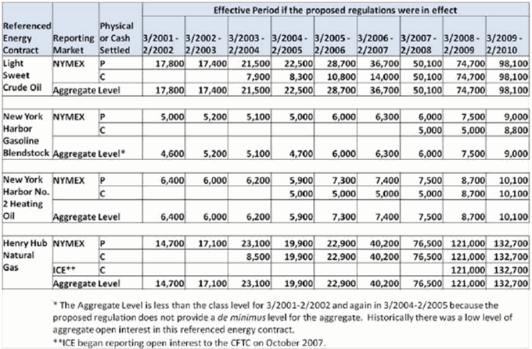
All Months Combined Referenced Energy Commodity Speculative Positions Under the Proposal (Prospective)
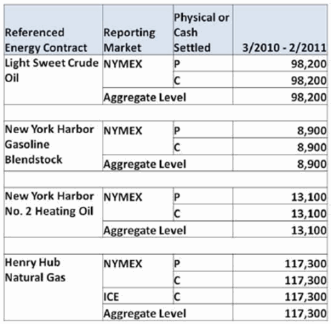
Exemptions
The notice of proposed rulemaking includes provisions relating to exemptions from the position limits for bona fide hedging transactions and for certain swap dealer risk management transactions. The notice of proposed rulemaking also sets out an application process that would apply to swap dealers seeking a risk management exemption from the position limits, as well as related definitions and reporting requirements. In addition, the notice of proposed rulemaking includes provisions regarding the aggregation of positions under common ownership for the purpose of applying the limits.
Should the proposed regulations be adopted, staff estimates that the total number of traders with significant positions that could be affected at the time of implementation of the proposed regulations would be approximately ten.
Proposed AMC Limits
From Jan.1, 2008 to Dec. 31, 2009 (Tuesdays Only)
|
Commodity Type |
Maximum Number of Owners Affected in One Day |
Number of Unique Owners during the Period |
|
Crude Oil |
2 |
3 |
|
Gasoline |
9 |
19 |
|
Heating Oil |
7 |
16 |
|
Natural Gas |
1 |
1 |
The table above illustrates how many traders would have been potentially restricted by the limits, had the proposed limits been in effect during the calendar years of 2008 and 2009. This data represents a weekly snap shot of traders as of each Tuesday, consistent with the way we disclose Commitment of Trader Reports to the public. For crude oil, the maximum number of unique owners affected by the all-months-combined limits would have been 2 on any given Tuesday. There were a total of 3 unique owners in crude oil over that two year sample that would have been affected. Across all 4 energy commodities, there would have been 23 unique owners affected. By affected, I don’t necessarily mean restricted. The traders may have been eligible for a bona fide hedging transaction or swap dealer exemption. From the data, it appears 7 unique owners would likely not have been eligible for an exemption.
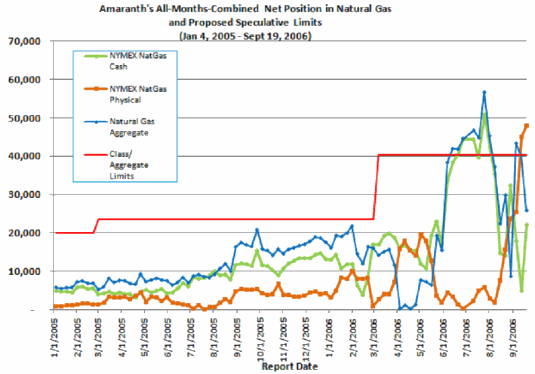
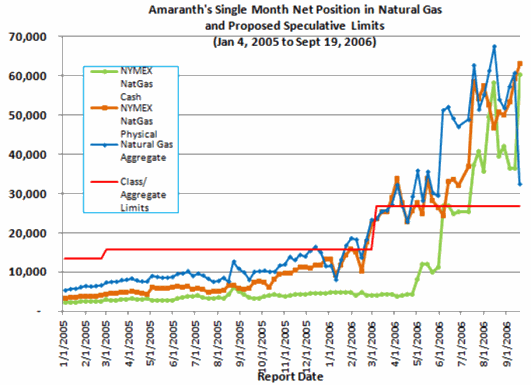
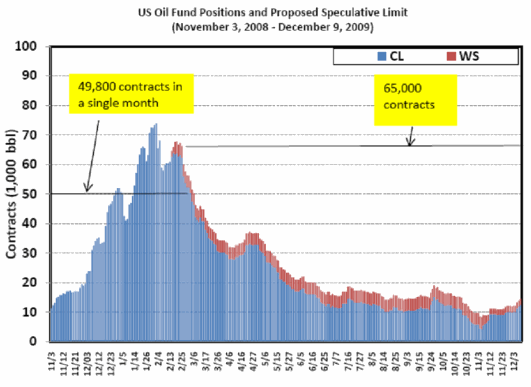
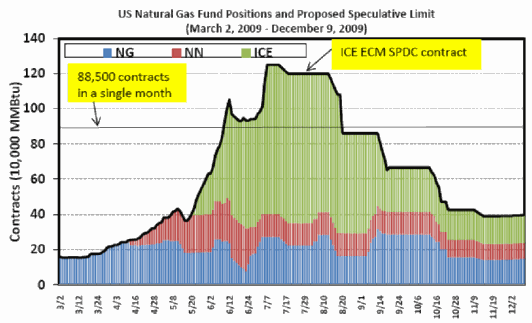
I note that the proposed Federal speculative position limits on energy contracts would be in addition to, and not a substitute for, a reporting market’s existing speculative position limit and accountability requirements. Reporting markets are self-regulatory organizations with an independent responsibility for adopting and implementing appropriate position limit and accountability rules. Under an exchange’s position accountability rules, once a trader exceeds an accountability level in terms of outstanding contracts held, the exchange has the right to request supporting justification from the trader for the size of its position, and may order a trader to reduce or not increase its positions further.
This notice of proposed rulemaking does not propose regulations that would classify and treat differently passive long-only positions. The notice would, however, solicit comment on specific issues related to large, passive long-only positions. In particular, the notice would solicit comments on how to identify and define such positions and whether such positions should, including collectively, be limited in any way.
1. The CME Group is the parent company of four DCMs: NYMEX, the Chicago Board of Trade (“CBOT”), the Chicago Mercantile Exchange (“CME”), and the Commodity Exchange (“COMEX”).
2. Under section 2(h)(7) of the Act, ECM contracts that have been determined by the Commission to be significant price discovery contracts (“SPDCs”) are subject to Commission regulation. 7 U.S.C. 2(h)(7). ECMs listing SPDCs (“ECM-SPDCs”) are also deemed to be registered entities with self-regulatory responsibilities with respect to such contracts. To date, ICE’s Henry Financial LD1 Fixed Price natural gas contract is the first and only ECM contract to have been determined by the Commission to be a SPDC under section 2(h)(7) of the Act. 74 FR 37988 (July 30, 2009).
3. US-based traders also enter into various energy contracts listed by the ICE Futures Europe Exchange (“ICE Futures Europe”), a London-based exchange. These energy contracts include futures on West Texas Intermediate (WTI) light sweet crude oil, a New York Harbor heating oil futures contract and a New York Harbor unleaded gasoline blendstock futures contract. All of the listed contracts directly cash-settle to the price of NYMEX futures contracts that are physically-settled. ICE Futures Europe is a foreign board of trade (“FBOT”) and, unlike NYMEX and ICE, is not registered in any capacity with the Commission. Instead, ICE Futures Europe and its predecessor, the International Petroleum Exchange, have operated in the US since 1999 pursuant to Commission staff no-action relief. CFTC Staff Letter No. 99-69 (November 12, 1999). Since 2008, ICE Futures Europe’s no-action relief has been conditioned on, among other things, the requirement that the Exchange implement position limit requirements for its NYMEX-linked contracts that are comparable to the position limits that NYMEX applies to its contracts. CFTC Staff Letter No. 08–09 (June 17, 2008); CFTC Staff Letter No. 08–10 (July 3, 2008). Generally, comparable position limits for FBOT contracts that link to CFTC-regulated contracts serve to ensure the integrity of prices for CFTC-regulated contracts.
Last Updated: January 24, 2011
